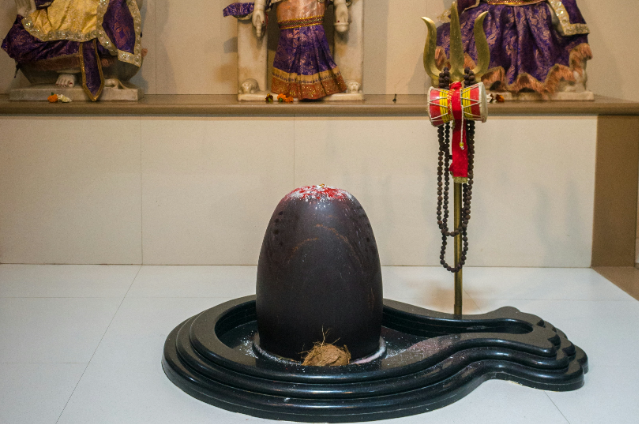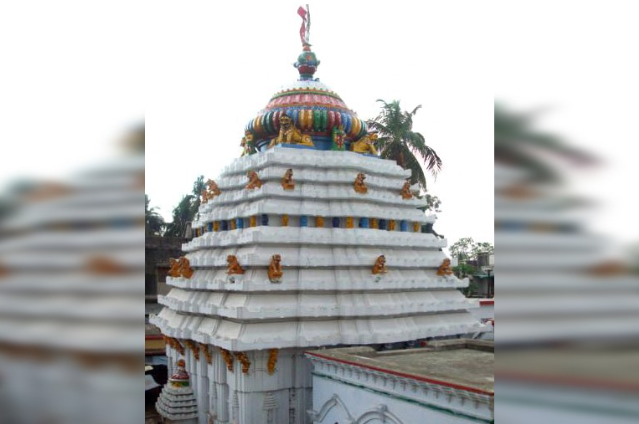
Photo by Sonika Agarwal on Unsplash / Representative Image
The worship of Lingam in India is of very ancient origin. We can find many temples in India where lord Shiva is worshipped in the form of Linga. Either it was formed naturally or created. Somnath Temple in Gujarat, Shankaracharya Temple in Srinagar, Amarnath shrine in Pehelgaon and Mahabaliswar Temple in Jammu are some of the famous Shiva Temples in India.
In Odisha, the same form of worship has been found since time immemorial. Some of the ancient Shiva temples are Lingaraj Temple in Bhubaneswar, Dhabaleswar in Cuttack, Panchulingeswar in Nilgiri, Chandaneswar in Jaleswar and Aradiswar in Bhadrak. The pristine glory of Shaivisim and the miracles of Akhandalamani are widely known and worshipped. Lord Akhandamanai, for many, is not just a deity but someone, who is part and parcel of their day-to-day, lives and bails them out whenever they are in trouble. The adage goes ‘Aradi re garedi nahin”. There is no black magic in Aradi bears a testimony to the fact that Babamani hears everybody’s prayers and heals all the inflictions of human beings. Aradi is a major pilgrim centre of Shaivism in the eastern part of India. Here, the Lord is worshipped in the form of Shiva Lingam. It is stretched out on both sides by the sacred daughter of Meghasan ‘Salandi River’ and the daughter of Gonasika ‘Baitarani River’.It is the meeting place which has been referred by famous odia poet Radhanath Ray in the Poem ‘USHA’. The poem was written in the year 1888. It means Aradi was famous in Odisha before 1888. It is 37 km away from Bhadrak Town and 12 km from Chandabali(An ancient port of Odisha). It is well connected with road and river routes throughout the year.
The sacred place of Babamani is known by various names such as Aradi, Akhandalamani pitha and Talaghati Thakura as told by local people. It is a historical place and the advent of Lord is quite obscure and mysterious. There is a strong belief among the people in the wonders of Mani Baba. It is believed that if anybody wishes anything in full dedication and diligence before Baba, it gets fulfilled. Sometimes people carrying with dreaded diseases get recovered by (Adhyaya padiba) completely surrendering before God. It has been proven in many incidents. Many people have got themselves cured from snake bites by taking Kundajala (Water from the sacred tank situated in the precinct of the temple). The faith is so deep rooted in the mind of the people that, they take the promise of Manika (Manika dwahi) before verifying the veracity of truth on any incident. The miracles and other wonder stories relating to Lord Akhandalamani are described in the famous book “ Panchanan Mela” by Deba Deba Das & Dasarathi Das. It is a Mela or Puja offered by a devotee when his/her wish gets fulfilled. It is observed throughout the state and this sacred book is kept with honor in almost every household of the state
Advent of Lord- A famous teacher of the area late Panchanan Das in his book ”Akhandalamani Bhagabat” has written about the advent of the Lord. A farmer was ploughing in the field (existing place of the shrine), and the plough share struck something underneath the ground. The farmer found it as a rock, broken on the upper part and profusely bleeding. At this moment ‘Aah’ sound was heard from the ground. This painful sound became the name of that place “Aradi’. The legend of broken rock worshipped as shiva lingam (Aradiswar) is also mentioned in the Odia book ‘Aradi Mahatmya”.
Legends declare that the area of Aradi was under Zamindari of Niladri Samarsingha Mohapatra, the ancestors of Zamindars of Burdwan district of West Bengal. Now it is a controversy whether the landlord was a Bengali or Odia. It is presumed that Samar Singh Mohapatra might be an odia as the descendants of Jhampula Singh Mohapatra) are still living with the same title on the other side of Baitarani.
It is found from the historical records of Kanika that the present temple was built by Harihra Bhanja and later on completed by Satyabhama of Bhanja Dynasty. It is again found from the order of Justice G.R.Rao of Munsif court “The origin of deity is quite obscure. No one knows who had installed it. It appears that the ancestors of Kanika got the present temple built and endowed the deity with some immovable properties and appointed two Brahmins of Jajpur district to attend it”. The two Brahmins appointed by Kanika Raja were gradually extended up to 55 sevayat families. It is presumed that up to the reign of Samar Singh Mohapatra, the shrine existed in the form of a wooden structure. The Shiva Lingam was protected from shower and Sun with the help of a palm leaf umbrella. Taking so many records into account the year 1404A.D may be considered as the approximate year of the advent of Lord Akhandalamani.
No dispute occurred between Sevayatas and Kanika Raja till the year 1921. But after that a conflict arose and the matter was taken to the court and the order was passed in favour of the servitors rejecting the right of the king or committee towards the sevapuja of the deity. Later on, a ruckus started among the servitors. King Kanika intervened in the matter and this power was given to the king by the servitors in a letter written as “Samarpana Patra”. Though it was dismissed by Justice Rao in the year 1941, still many of the rules mentioned in it are in vogue.
Sevapuja- Lord Akhandalamani is worshipped regularly five times in the divine way of sodasa upachara (sixteen divine ways of worship). This process is known as prahara. After Mangala Alati, the door of the temple is opened with the blowing of conch shells. The most important Besha (Attire) is the Badasinghar Besha or Raja Besha. The most favourite form of worship is pouring water on top of the Lingam. It is known as JalaAbhisek. Generally, the priest pours water on the top of the Linga and rubs it with cheese curd and honey. This type of offering is known as Gharsana (Mixture of all). It is relished by devotees as one of the best offerings available in Aradi.
All the devotees coming from far-off places take it with heart content. Like the daily work of a human being, the Lord takes a rest after every Prahara or worship. After Badabhoga (Usually lunchtime), the door of the temple is locked for a few hours and again is opened at 3 pm. Every prahara (Pahada) has a different Besha as mentioned in the temple record. The attire of the second prahara is known as Jogi Besha(Attire of Ascetic). As the evening approaches, Badasinghara Besha is held. The site of this Besha is so attractive that seeing is only believing. It resembles the unique image of Harihara. Lord remains with this Besha up to the next morning. The temple is allowed to open up to 10 pm in the night for the darshan of devotees. The methods, rituals, and ways of worship have been going on from ancient times perhaps since the reign of Kaniaka Raja.
Shiva Ratri--It is the most important as well as the most famous annual celebration of Lord Shiva. On this day lakhs of people from every nook and cranny of the country throng to the holy place of Aradi to have a glimpse of Mahadipa (Big Earthen Lamp) to be placed atop the Shrine. Unlike other Siva temples of the state, the Mahadipa is taken atop of the temple towards the last phase of the night in Aradi. Diya reflects the brilliant radiance of light that can be visible from a long distance. As soon as the devotees see the Diya(Mahadipa) going upwards, they welcome it with Uluation (Hulahuli) and with the sound of cymbals and conch shells. At this moment, the whole ambience is reverberated with the sound of “Haribol” and “Omm Namah Sibaya”. No one can describe that divine scene with words. Mahadipa is generally an earthen pot made out of clay and is filled with near about 20 kg of ghee offered by the devotees. The Salita (a cloth made for flame), is a cloth of about 10 feet long Dhoti (A loin cloth). It is raised in Diya (Maha Dipa) fully smeared with ghee.
The architecture of the Temple-The structure of the temple seems to be a mixture of Utkal and Dravidian art of architecture. The height of the temple from the ground is 150ft. It has one Natamandir (Hall of Dance) and Mukhasala (Entrance Gate). The temple complex has other deities and is enclosed by a large compound wall.
In the north side of the shrine ‘Parvati’, in the west ‘Kartikeya’ and in the south ‘Ganesh’ images are worshipped. It is known that an ascetic named as Darshan Das had built the compound wall and another person named Narasingha Das had built the main entrance (Mukhasala) of the temple. A beautiful pond named ‘Sivaganga’ situated in front of the temple is connected with Baitarani by a channel called ‘Shivmahara’. Trident is placed on the top of the Shrine. A big hole of near about 30 ft is there inside the temple in front of the Lingam. It is believed to be the mysterious room of the Lord. During the British period, it was once tried by one officer to open a hole covered by a huge rock, but the hissing sound of a snake refrained him from opening it. It remains a mystery as the very existence of the Lord is itself a mystery.
Now the temple is preserved and taken care of by ASI (Archeological Survey of India). It is run by a Trusty Board. A Manager and a few staff members have been recruited by Govt. of Odisha under the Hindu Endowment Commission Act to look after the daily rituals of Lord Akhanadalamani.
No doubt, ‘Aradi’ holds a prominent place in the cultural map of India; still a lot of developmental works are to be carried out. Improper and clumsy residences of servitors in and around the temple create a problem for communication. The garbage littered around the wall of the temple stinks and creates an unhygienic atmosphere. Govt. and private organizations must come forward to make this holy place a beautiful centre of pilgrimage. During the time of the rainy season, rainwater enters into the sanctum sanctorum of the temple hampering daily rituals of the Lord.
Though many scholars have unravelled the history of this place, still a lot of research is required to explore the mystery of this mysterious creation.
. . .
References:
- Panda.Babaji Charan(2015)” Bisha Kantha Babamani”, Bhadrak.
- Das. Deb Deb, Das.Dasarathi, “Panchnan Mela”.
- Das.Late Panchnan Das “Akhandalamani Bhagabat’.
- Behuria.Karunakar ‘Odia Article on Akhanadamani’ ‘Prabandha Piyush’.

